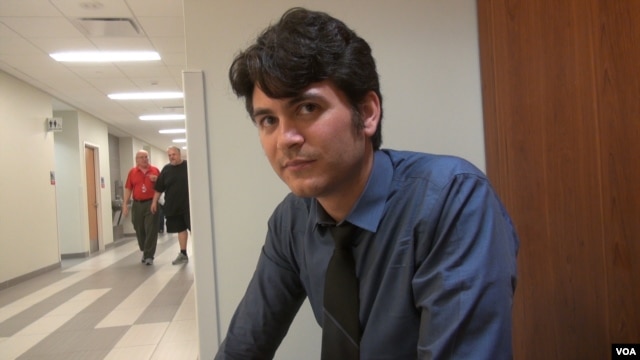
Green Party Seeks Sanders Supporters to Expand Its Base
Greg Flakus
VOA News
HOUSTON—The Green Party is appealing to disgruntled supporters of Vermont Senator Bernie Sanders and millions of young voters saddled with student loan debt in an attempt to challenge the two-party dominance of U.S. politics.
Political experts and pundits see little hope the small party can achieve that goal, but these same experts admit to having been confounded by many of this year’s developments.
At the Green Party national convention Saturday in Houston, delegates nominated Massachusetts physician Jill Stein for the presidency, amid chants of “Jill, not Hill” — a reference to Democratic Party presidential nominee Hillary Clinton, who was described by speakers as an “oligarch,” “a tool of Wall Street” and “a warmonger.”
Many of the people on hand at the convention wore Sanders T-shirts and buttons. They were disappointed by Clinton’s eventual victory and angered when the Wikileaks group released emails showing Democratic leadership favoritism toward Clinton.
Graham Cabrera, who was at the Democratic Convention in Philadelphia, told VOA he saw party officials suppress the Bernie Sanders supporters. «It was complete censorship,» he said. (G. Flakus/VOA)
Graham Cabrera, who was at the Democratic convention in Philadelphia, told VOA he saw party officials suppress the Sanders supporters.
“I saw firsthand what happened,” he said. “It was complete control, it was complete censorship, it was complete disenfranchisement of Bernie supporters and Bernie delegates.”
Democratic Party officials deny there was any fraud at their convention, and Sanders endorsed Clinton and spoke at the convention.
‘Same values’ as Sanders
Ryan Trundle, who was a Sanders delegate at the Democratic convention, wore a Bernie cap to the Green Party gathering in Houston and dyed his beard green to demonstrate his enthusiasm for Stein.
“She has the same values and morals as Bernie Sanders and stands for the same things,” he said.
Ryan Trundle of Shreveport, La., a former Bernie Sanders delegate at the Democratic convention, wore a Bernie cap to the Green Party gathering in Houston and dyed his beard green to demonstrate his enthusiasm for Jill Stein. (G. Flakus/VOA)
Trundle said he was part of a network of 5,000 Sanders supporters, 90 percent of whom, he said, planned to vote for Stein.
But recent polls showed that more than 80 percent of Sanders supporters nationwide were planning to vote for Clinton. Many said they still disliked Clinton but saw her as the lesser of two evils when comparing her with Republican presidential nominee Donald Trump.
In her acceptance speech, Stein rejected the idea of voting for Clinton just to defeat Trump.
“We are saying no to the lesser evil and yes to the greater good,” she said.
Stein is on the ballot in only 21 of the 50 states, and although she expects that number to rise, it is already too late for her and running mate Ajamu Baraka to be included in at least three states. But Stein sees an opportunity this year to attract not only Sanders voters, but also young people who carry loads of student loan debt and often work at low-wage jobs despite having college degrees.
Potential support
Speaking at the end of the convention, Stein told of her plan to eliminate student debt.
“There are 42 million people who are locked in predatory student loan debt,” she said, “That is enough to win the election, right there.”
Former Bernie Sanders supporter Veronica Triagle says she thinks the Green Party can attract many of young voters for whom the student loan debt issue is a major concern. (G. Flakus/VOA)
Sanders supporter Veronica Triagle, 25, told VOA she thought the Green Party could attract many of those voters. If they listen to Stein, she said, «people are going to see that they actually have a lot in common with her beliefs.”
The biggest impact the Green Party had in a presidential election occurred in 2000, when it nominated activist Ralph Nader as its presidential candidate. Although he won less than 3 percent of the national popular vote, he may have won sufficient votes in some key states, notably Florida, to allow Republican candidate George W. Bush to defeat Democratic candidate Al Gore.
In the 2012 election, however, Stein was the candidate, and she won just 0.36 percent of the nationwide popular vote.
Looking toward 2020
But given the unpopularity of the two major party candidates this year, some political observers see the Green Party and the Libertarian Party, the largest of the minor parties in the United States, in a position to expand their voter base in preparation for the next presidential election in 2020.
Some recent polls have shown the Libertarian presidential candidate, former New Mexico Governor Gary Johnson, with 8 percent support and Stein with around 5 percent.
Neither party is close to the 15 percent needed to be allowed into the presidential debates scheduled for September and October.
But if a party wins more than 5 percent of the national popular vote in this year’s election, it would qualify for public campaign funds in the next election. The Green Party accepts no corporate donations and relies on individual contributors, so gaining several million dollars in this way could have an impact four years from now.




